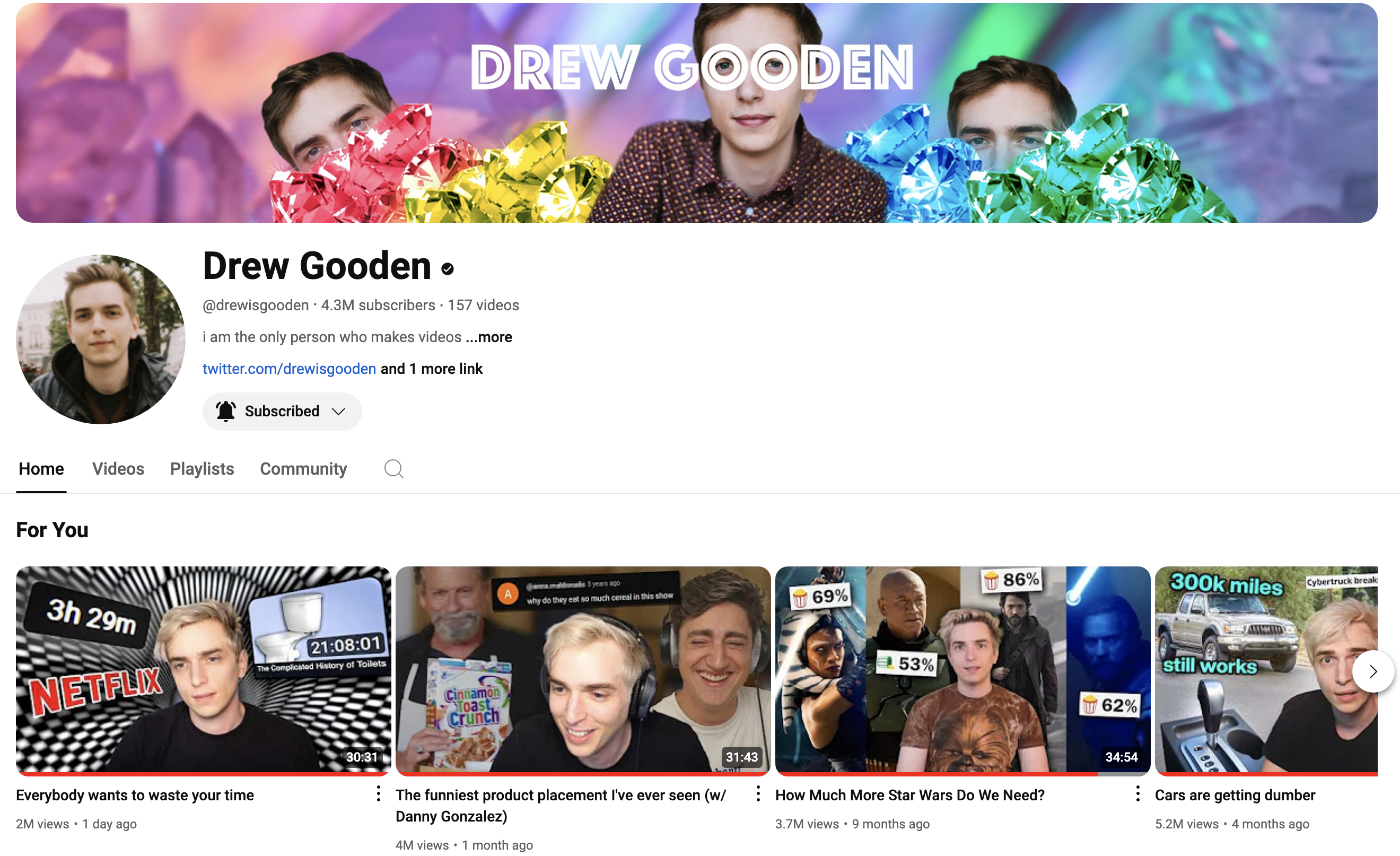Culture
REVIEW: How Drew Gooden became an unlikely champion for creativity

“Hey guy, does anyone else feel like everything is designed to waste your time now? Or am I being too cynical?”
Drew Gooden begins his latest video essay on YouTube, titled ‘Everybody wants to waste your time,’ with a short skit meant to make fun of the way that many recent documentaries are made to feel. Even if the mock interview between the documentarian and John who works at HobbyLobby is just part of a hyperbolic sketch, it does reflect a real-world issue. Although many may deem the quality of content they consume a trivial issue, this 30-minute conversation that Drew Gooden has with his viewers is thoroughly convincing that perhaps it should be something more people should care about.
This isn’t the first time he’s made such a poignant video on what could seem, at first glance, as unimportant issues. For example, ‘AI is ruining the Internet,’ ‘Tiktok hates your relationship,’ and ‘The Future of TV is Bleak’ are all examples of some incredible work from the Vine-turned-YouTube star. The first, for example, has even had a soundbite taken from towards the end of his rant and turned into a sound to be used on TikTok and Instagram to show off how much more talent and soul goes into human made art compared to AI generated images.
Even his more comedic, laidback videos often have a final or underlying deeper message, such as discussing the way that excessive fame can harm someone’s career, or the need for profit overrides the need for quality entertainment. American magazine Paste described Drew Gooden’s style of videos as his “own comedic version of investigative journalism”.
Real art takes time.
While some, including himself, can doubt Gooden’s opinions as cynical or inconsequential, his videos over the last few years have raised so many concerns and issues over the quality of our entertainment. From reviews of the various Star Wars TV series and films released since Disney bought the rights to the franchise and upset over the Netflix adaptation of Avatar: The Last Airbender, to speeches about cars becoming ‘dumber’ and bizarre products that one can buy on social media, Drew Gooden provides some hope to a generation with seemingly exponential growth in technology that perhaps art is not dead.
He explores – in enough depth to be interesting, but short enough time to not become background noise – the way that real art takes time, practice, and effort. Good quality television, for example, cannot be made from simply recycling ideas and underpaying staff, and products sold for mental health or physical fitness cannot be cheap placebos or a means to just make money without providing a decent service.
In a time where it feels as if profit is all that matters now for entertainment executives and app developers, it is so important for people to remember that they deserve better. Gooden mixes his fantastic sense of humour with a plea for change from this downward spiral that society seems to be heading in, all to create these videos. He tries to motivate his watchers to keep creating what they can, to keep the spark of creativity alive.
He urges them to not fall for Internet scams and seek help when they need it, to take care of themselves. He may not have the power or money to change the minds of CEOs such as Elon Musk or Jeff Bezos, and he doesn’t expect to. But what he does do is start discussions amongst his fans and make sure they are aware of what they are consuming – to think just a bit more critically about what they watch on Netflix or what ads they click on when scrolling through Instagram.
Gooden is a bastion for natural creation.
And, as he jokes about in this latest video of his, even if his video essays are not always on a topic that is something the viewers are already interested in or aware of, his own passion comes through and engages the audience, making sure they listen to his every word – unlike a lot of the media he criticises.
It is always important to have people advocate for creativity and self-expression, especially when the arts always feel underfunded (for example, the UK government has a long-standing habit of decreasing state funding for the arts, such as funds for cultural organisations falling 18% between 2009 and 2023).
Additionally, the discussion around artificial intelligence and how it is trained on real human art has added something new to the equation – is artistic skill something that everyone can now access, or does it simply decrease the value of art that takes time and effort?
The end of Gooden’s video AI is ruining the internet is powerful; although he feels “so lucky” to live in a time where creating is more accessible and cheaper than ever and he understands “how tempting shortcuts can be,” he urges people to understand that creation and art, no matter the medium, takes time, effort, trial and error.
It’s emotional to listen to as someone who considers their life to revolve around creativity, when he talks about “turning a blank word document into multiple pages of something you’re proud of” being the fun part.
It is this final speech about taking the time to practise, learn and grow, that has been taken to heart and spread across social media, allowing people to show off their own work, what they have worked on over months, years, or their entire lives.
Gooden is a bastion for natural creation, self expression and being yourself in a digital world full of AI art, expensive streaming services and immense social pressure to conform. It was already impressive to watch him grow from 6-second comedy videos to 25-minute YouTube videos, but taking into account his current projects, it will be so much more exciting to see where he goes next and where this worldview will take him.
Culture
Where confidence takes centre stage: How theatre transforms

Performing arts education isn’t just about learning to act, dance, or sing – it’s vital in developing many young people’s confidence and self-expression.
In a digital age where young people are spending more time on their devices than ever before, theatre education provides lifelong skills like communication, resilience and teamwork.
I caught up with some of the students at Artisan Theatre School, a Hampshire based youth theatre club, to see if this rings true.
Ben, 18, said his time at theatre school has “helped develop people skills” and made him “a more confident person”.
He urged other young people to “get involved and enjoy it!”
Daniel, 17, shared a similar sentiment saying his “confidence has grown a lot”.
Theatre education can open a whole world of new opportunities for young people, giving them the space to discover their talents and explore future career paths.
Lucy, 17, has attended Artisan Theatre School for nine years and said: “I want to be a performer in some capacity.”
She added: “That’s my dream because of Artisan.”
Emma, a singing teacher at the school, said performing arts education is “beneficial to anyone,” not just those pursuing it professionally.
She added it can be especially valuable for children with SEN, helping them build confidence, improve communication, and “come out of their shell” in a supportive environment.
Unfortunately, despite its benefits, arts education is not guaranteed for every young person.
Cuts to funding over the last decade has had a significant impact, limiting access to creative learning opportunities.
The Cultural Learning Alliance’s 2025 report reveals a 42% decrease in Creative Arts based GCSE entries since 2010, and a 27% decline in the number of Arts teachers.
Sam Blackwell, principal and founder of Artisan Theatre School, said arts education is “really important” and that “they don’t do enough of it in schools”.
She explained that her vision in creating the school was to “give back more to kids and get them being confident”.
To help fill the gaps left by reduced arts provision in schools, Sam plans to introduce additional classes and offer increased opportunities for her students to learn from industry professionals.
Culture
And we all keep dancing for it can’t get any worse (90s/00s)

The Shakespearean nature of Tony Blair’s time as Prime Minister is something that had never been seen and his obsession with “the spin” that had won him the 1997 election and made him one of the most popular prime ministers when entering office.
With large proportions of the public optimistic for his premiership incoming.
A fall from grace would ensue much like Macbeth.
It would be cruel and untrue to reflect on Tony Blair’s premiership to say that it was a complete failure, especially as many still see him as one of the best PMs the UK has ever had.
Since one of the biggest landslides in UK election history in 1997, he was able to push through many socialist policies without much of a hassle: inflation was low, crime was down by a third, children were achieving some of their highest results ever in school, thousands more students were going to university, a million pensioners and three million children had been taken out of poverty, the quality of the air, beaches, and drinking water was as clean as before the industrial revolution.
However 9/11 changed everything. The era of youthful optimism and rebellion has been replaced by what a lot of thinkers call post-post modernism.
At site Zero, George Bush claimed that “those who are responsible must be brought to justice.”
He outlined Cuba, Iran, Libya, Syria, North Korea and most importantly Iraq.
Once the troops stepped into Iraq, it was the start of a domino effect that quickly decimated Blair’s time as PM.
Unlike Kosovo and Sierra Leone, Britain’s involvement in Iraq did not have the public’s support.
In his book The Prime Ministers, Steve Richards remarks that Tony Blair had not assumed any cabinet position in the lead up to his premiership and asks:”What if Blair had been foreign secretary? at least he would’ve seen, and interpreted intelligence – an explosively contentious issue in the run-up to the Iraq War.”
And then, the day after London had been announced as the host of the 2012 Olympics, on the 6th of July 2005, 7/7 happened.
Four terrorists detonated bombs on public transport – 52 killed and 784 were injured.
When times get tougher and life gets sadder, what do people do? Dance to forget
Prince William and Kate were leaving a Chelsea nightclub at 3am, Prince Harry was partying with Kanye West and getting into a scuffle with photographers at 4am.
The 2000s club scene was here and everyone was taking part; it was loud, it was abrasive, and it was here to stay.
Since the introduction of the stifling 1994 Criminal Justice Act, which is considered to have brought the illegal rave era largely to a close, “free parties” were the new get-around of the law: Student clubs offering “buy one, get three free” on alcopops and 50p doubles for an hour.
Halls bars were £1.20 a pint. Artists like LCD Soundsystem, Missy Elliot and Rihanna began their rise to fame with dirty, booming soundscapes that captured the drug-fuelled atmosphere of clubs as everyone dances to a beat that never seems to end, drenched in sweat.
Films like Trainspotting capture the allure of 2000s clubbing but the grim reality, drugs have found their way into the club scene.
Much like the Oasis album Standing on the Shoulder of Giants is described as Oasis’ “come down album”, the 2000s was a comedown era of clubbing.
The times were sad, but the music got louder?
As David Cameron’s government entered Number 10 Downing Street in 2010 and ushered in 14 years of austerity, where exactly would clubbing culture go with almost all clubs closing….
Culture
REVIEW: Sigrid – There’s Always More That I Could Say

2 out of 5 stars
A disappointing third album filled with negativity
In all honesty, I was late to Sigrid’s party.
I started following the Norwegian pop star in 2023 when she had already released two albums and completed a slew of EPs and international tours.
In no time at all, I was captivated by her rasping tones, funky rhythms, and cool electronic synths.
When news broke that her third album would be releasing on 24 October, it was no surprise to find myself listening and assessing it…
Jellyfish is the first single and the most lighthearted. I like it.
It’s a nice story about two people meeting at a dance and kindling a relationship.
Sigrid sings in a syncopated rhythm, giving a jazzy tone to the tune.
For the first time in her career, she includes a flute.
Cold, gritty, grim
It plays a flourish at the beginning but I can’t hear it throughout the rest of the track. It would be good to hear more of the flute in future.
Fort Knox is single number two. As the name suggests, this is a cold, gritty, grim song about a woman betrayed by her man.
This betrayal cuts so deep that she has retreated into her shell to “lock my love up in… Fort Knox”.
I enjoyed the dramatic, dark nature here, especially the war cry chorus throughout the song.
Towards the end, you would think the song has finished before it plays one more crescendo of strings to cap things off. I thought that was unnecessary.
The third single, Two Years, is written from the perspective of the woman’s boyfriend, another new departure for Sigrid.
He has been chasing for that exact period of time. It’s a cheery song with a strong beat, despite the desperate lyrics like: “What are you running from? / Why did you let me go?”
I’ll Always Be Your Girl is another sad song of frustration and heartache caused by a rowdy, hot-headed partner.
It is sung very well, especially the pleading chorus line, and the drum-guitar combination gives me something to nod along to.
Unconventional energy
Do It Again is the most unremarkable song on the album.
There is a good guitar and drum track, however the story again is quite predictable for Sigrid (being tempted to rekindle on old flame relationship).
Kiss The Sky returns to more unconventional energy which is great.
A lovely fade into the track leads into the main verses.
This time, Sigrid is speaking her verses with a distorted effect rather than singing them. It sounds good and complements her natural raspiness.
A strong guitar riff carries us through the bridge. The electronic synths make this seem like a 1980s dance track.
It’s only the lyrics that make this song a story of disappointment between lovers.
There is sexual innuendo in Hush, Baby, Hurry Slowly.
You could interpret it as a man and woman deciding whether to move forward with their relationship.
You could see it as partners deciding whether to have sex or not.
As a result, it’s an interesting song and makes you listen to try and work it out.
The structure shakes things up by starting with the chorus fading in.
The song ends with the melody slowing down and lowering in pitch, reflecting the title in musical terms.
The title track is the obligatory solo piano song.
Sigrid has had at least one piano focused song in all albums.
This is the most beautiful song in the album, featuring solo piano and a nice resonance on the voice.
The lyrics still contain tensions between people, like “giving…my worst” as a girlfriend.
Nevertheless, this is my favourite song from this year’s collection.
The penultimate track is also the longest in the album.
Have You Heard This Song Before picks up the energy from the previous song with a predictable but welcome mix of drums and synths.
The lyrics are pretty hopeful in tone about wanting to spend time with your partner. This is the most positive track on the album.
The last song, Eternal Sunshine, is a conventional finale song.
It has a regular beat and instrumentation.
It is another song built out of frustration with a partner – she wants to “drink” him out of her mind.
It would have been nice to have something different to end on – maybe a different topic.
This is the shortest album Sigrid has released. That is disappointing.
There are 10 songs in only 31 minutes.
I would have expected the usual 12 tracks or more.
The previous albums managed it fine.
Sucker Punch (2019) and How To Let Go (2022) contained 12 songs. The Special Edition of How To Let Go added 15 songs on top of the originals.
This album differs from the last two in that every song but one is constantly loud, energetic, and pumping.
I would have preferred more balance between softer and pounding songs.
How To Let Go had more positivity in it, such as singing in a taxi, body-confidence in the mirror and making the most of life.
This album has replaced that with disappointment and frustration.
It is the album with the most “explicit” songs – never before have we had an album with so much swearing.
I hope that is toned down in future.
Here’s hoping that the next album is more positive, unconventional and creative.
Perhaps that will come out in three years, like the others.
There’s always more that Sigrid could say (sorry, that was a terrible joke).
-

 Winchester News Online2 years ago
Winchester News Online2 years agoWinchester M3 Junction 9 hit with environmental concerns
-

 News2 years ago
News2 years agoFestive Santa Fun Run is here again!
-

 Culture2 years ago
Culture2 years agoREVIEW: Oh What A Lovely War at MAST Mayflower Studios
-

 Sport2 years ago
Sport2 years agoTwo late goals see Blues victorious in Romsey
-

 Sport1 year ago
Sport1 year agoSaints Legends fall to penalty shootout defeat
-

 Winchester News Online12 months ago
Winchester News Online12 months agoUoW Futsal 2nds claim their first ever win over their senior Winchester rivals
-

 Winchester News Online11 months ago
Winchester News Online11 months agoFeeling down in winter is often regarded as winter blues, it may however be something a lot more serious
-

 Winchester News Online1 month ago
Winchester News Online1 month agoGreenham Common holds half marathon in aid of baby charity
